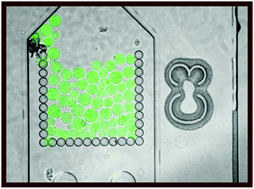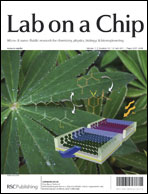Contamination with arsenic is a recurring problem in both industrialized and developing countries. Drinking water supplies for large populations can have concentrations much higher than the permissible levels (for most European countries and the United States, 10 μg As per L; elsewhere, 50 μg As per L). Arsenic analysis requires high-end instruments, which are largely unavailable in developing countries. Bioassays based on genetically engineered bacteria have been proposed as suitable alternatives but such tests would profit from better standardization and direct incorporation into sensing devices. The goal of this work was to develop and test microfluidic devices in which bacterial bioreporters could be embedded, exposed and reporter signals detected, as a further step towards a complete miniaturized bacterial biosensor. The signal element in the biosensor is a nonpathogenic laboratory strain of Escherichia coli, which produces a variant of the green fluorescent protein after contact to arsenite and arsenate. E. coli bioreporter cells were encapsulated in agarose beads and incorporated into a microfluidic device where they were captured in 500 × 500 μm2 cages and exposed to aqueous samples containing arsenic. Cell-beads frozen at −20 °C in the microfluidic chip retained inducibility for up to a month and arsenic samples with 10 or 50 μg L−1 could be reproducibly discriminated from the blank. In the 0–50 μg L−1 range and with an exposure time of 200 minutes, the rate of signal increase was linearly proportional to the arsenic concentration. The time needed to reliably and reproducibly detect a concentration of 50 μg L−1 was 75–120 minutes, and 120–180 minutes for a concentration of 10 μg L−1.

You have access to this article
 Please wait while we load your content...
Something went wrong. Try again?
Please wait while we load your content...
Something went wrong. Try again?


 Please wait while we load your content...
Please wait while we load your content...